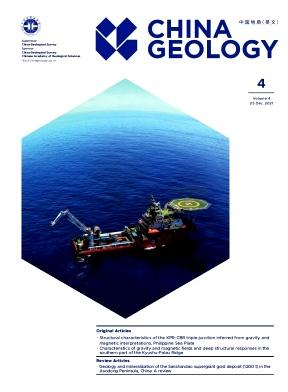Optimization of lithium extraction solar pond in Zabuye Salt Lake: Theoretical calculation combined with field experiments
IF 4.7
3区 地球科学
Q1 GEOSCIENCES, MULTIDISCIPLINARY
引用次数: 0
Abstract
This research optimized the structure of lithium extraction solar ponds to enhance the crystallization rate and yield of Li2CO3. Using the response surface methodology in Design-Expert 10.0.3, the authors conducted experiments to investigate the influence of four factors related to solar pond structure on the crystallization of Li2CO3 and their pairwise interactions. Computational Fluid Dynamics (CFD) simulations of the flow field within the solar pond were performed using COMSOL Multiphysics software to compare temperature distributions before and after optimization. The results indicate that the optimal structure for lithium extraction from the Zabuye Salt Lake solar ponds includes UCZ (Upper Convective Zone) thickness of 53.63 cm, an LCZ (Lower Convective Zone) direct heating temperature of 57.39°C, a CO32- concentration of 32.21 g/L, and an added soda ash concentration of 6.52 g/L. Following this optimized pathway, the Li2CO3 precipitation increased by 7.34% compared to the initial solar pond process, with a 33.33% improvement in lithium carbonate crystallization rate. This study demonstrates the feasibility of optimizing lithium extraction solar pond structures, offering a new approach for constructing such ponds in salt lakes. It provides valuable guidance for the efficient extraction of lithium resources from carbonate-type salt lake brines.
扎布叶盐湖提锂太阳能池优化:理论计算与现场试验相结合
本研究通过优化太阳能提锂池的结构,提高了Li2CO3的结晶速率和收率。利用Design-Expert 10.0.3中的响应面方法,对太阳能池结构相关的4个因素对Li2CO3结晶的影响及其相互作用进行了实验研究。利用COMSOL Multiphysics软件对太阳能池内的流场进行了计算流体动力学(CFD)模拟,比较了优化前后的温度分布。结果表明,扎布叶盐湖太阳池提取锂的最佳结构为:上对流区(UCZ)厚度53.63 cm,下对流区(LCZ)直接加热温度57.39℃,CO32-浓度32.21 g/L,纯碱添加浓度6.52 g/L。经过优化后,与初始太阳能池工艺相比,Li2CO3析出量增加了7.34%,碳酸锂结晶速率提高了33.33%。本研究证明了锂提取太阳能池结构优化的可行性,为盐湖锂提取太阳能池的建设提供了新的途径。为碳酸盐岩盐湖卤水中锂资源的高效提取提供了有价值的指导。
本文章由计算机程序翻译,如有差异,请以英文原文为准。
求助全文
约1分钟内获得全文
求助全文

 求助内容:
求助内容: 应助结果提醒方式:
应助结果提醒方式:


